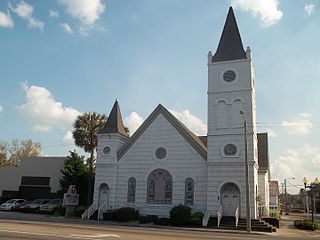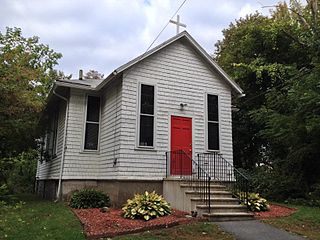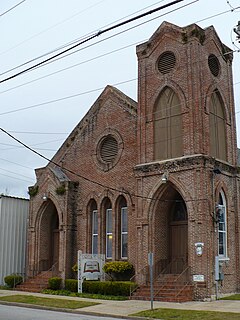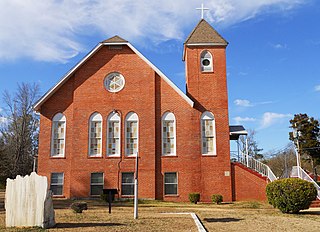
The African Methodist Episcopal Church, usually called the AME Church or AME, is a predominantly African-American Methodist denomination. It adheres to Wesleyan-Arminian theology and has a connexional polity. The African Methodist Episcopal Church is the first independent Protestant denomination to be founded by black people, though it welcomes and has members of all ethnicities. It was founded by Richard Allen (1760–1831) - later elected and ordained first bishop in Philadelphia, Pennsylvania, in 1816 from calling together of five black congregations of the earlier established Methodist Episcopal Church on the East Coast / Middle-Atlantic states area in the first General Conference, who wanted to escape the discrimination that was commonplace in society. It was among the first denominations in the United States to be founded for this reason, rather than for theological distinctions, and has persistently advocated for the civil and human rights of African Americans through social improvement, religious autonomy, and political engagement, while always being open to people of all racial backgrounds. Allen, an previously ordained Deacon in the Methodist Episcopal Church, was elected by the gathered ministers and ordained / consecrated as its first bishop in 1816 by the first General Conference of the five churches - extending from the three in the Philadelphia area in Pennsylvania to one in Delaware and one in Maryland of Baltimore. The denomination then expanded west and through the South, particularly after the American Civil War (1861–1865). By 1906, the AME had a membership of about 500,000, more than the combined total of the two other predominantly Black American denominations - the Colored Methodist Episcopal Church in America and the African Methodist Episcopal Zion Church, making it the largest major African-American denomination of the Methodist traditions.

The Mother Bethel African Methodist Episcopal Church is a historic church and congregation at 419 South 6th Street in Center City Philadelphia, Pennsylvania, USA. The congregation, founded in 1794, is the oldest African Methodist Episcopal congregation in the nation. Its present church, completed in 1890, is the oldest church property in the United States to be continuously owned by African Americans. It was designated a National Historic Landmark in 1972.

The Christian Methodist Episcopal (C.M.E.) Church is a historically black denomination within the broader context of Wesleyan Methodism founded and organized by John Wesley in England in 1744 and established in America as the Methodist Episcopal Church in 1784. It is considered to be a mainline denomination. The CME Church was organized on December 16, 1870 in Jackson, Tennessee by 41 former slave members with the full support of their white sponsors in their former Methodist Episcopal Church, South who met to form an organization that would allow them to establish and maintain their own polity. They ordained their own bishops and ministers without their being officially endorsed or appointed by the white-dominated body. They called this fellowship the Colored Methodist Episcopal Church in America, which it remained until their successors adopted the current name in 1954. The Christian Methodist Episcopal today has a church membership of people from all racial backgrounds. It adheres to Wesleyan-Arminian theology.

The African Methodist Episcopal Zion Church, or the AME Zion Church (AMEZ) is a historically African-American Christian denomination based in the United States. It was officially formed in 1821 in New York City, but operated for a number of years before then. The African Methodist Episcopal Zion Church adheres to Wesleyan-Arminian theology.

The black church is the faith and body of Christian congregations and denominations in the United States that minister predominantly to African Americans, as well as their collective traditions and members. The term "black church" can also refer to individual congregations.
Black Methodism in the United States is the Methodist tradition within the Black Church, largely consisting of congregations in the African Methodist Episcopal (AME) and African Methodist Episcopal Zion denominations.

The Mount Zion African Methodist Episcopal Zion Church, also known as the Mount Zion AME Zion Church Memorial Annex, is a historic church in Montgomery, Alabama, United States. Located on 467 Holt Street, it was built in 1899 and extensively remodeled in 1921.

The Goodwin Memorial African Methodist Episcopal Zion Church is a historic church on Woodside Avenue in Amherst, Massachusetts. It is a member of the National African Methodist Episcopal Zion Church denomination, which is historically African American and began in the United States. The history of the Goodwin Memorial African Methodist Episcopal (A.M.E.) Zion Church in Amherst, Massachusetts is an important part of the broader context of African American history. The A.M.E. Zion denomination was created in conjunction with growing African American identities. Locally, the Goodwin Memorial A.M.E. Zion Church is one of the few physical structures that speaks to the rich African American history and heritage in the town of Amherst and surrounding areas.

St. John's-In-The-Prairie, now known as St. John's Episcopal Church, is a historic Episcopal church in Forkland, Alabama.

Emanuel African Methodist Episcopal Church is a historic African Methodist Episcopal Church congregation in Mobile, Alabama, United States. Emanuel AME began when church trustees purchased a vacant lot for their church in 1869, as African Americans in Mobile established their own congregations following the American Civil War. The trustees completed a frame building in that same year. The frame building was altered in 1881 when James F. Hutchisson, a locally prominent white architect, was hired to design a new facade. The existing building was faced in brick and the facade was redesigned in the Gothic Revival style. This made Emanuel AME Church comparable to white churches in the city and superior to both African American and white rural churches of the period. The building was added to the National Register of Historic Places on May 29, 1987, due to its architectural and historic significance.

St. James AME Zion Church is a historic African Methodist Episcopal Zion church located at Ithaca in Tompkins County, New York. It is a two-story, frame church structure set on a high foundation and featuring a four-story entrance tower. The church structure was begun in the 1830s and modified many times since. The original stone meetinghouse was built in 1836 and is believed to be Ithaca's oldest church and one of the oldest in the AME Zion system.

The Metropolitan African Methodist Episcopal Zion Church is a historic Methodist Episcopal Church at 2051 Main Street in Hartford, Connecticut. This High Victorian Gothic structure was built in 1873-74 for an Episcopal congregation, and has since 1926 been the home to the city's oldest African-American congregation, which was established in 1833. The church was listed on the National Register of Historic Places in 1994.

Old Ship African Methodist Episcopal Zion Church is a historic African Methodist Episcopal Zion Church in Montgomery, Alabama. It is the oldest African American church congregation in the city, established in 1852. The current Classical Revival-style building was designed by Jim Alexander and was completed in 1918. It is the fourth building the congregation has erected at this location. Scenes from the 1982 television movie, Sister, Sister, were shot at the church. It was placed on the Alabama Register of Landmarks and Heritage on March 3, 1976, and the National Register of Historic Places on January 24, 1991.

Wesley A.M.E. Zion Church is a historic church at 1500 Lombard Street in Philadelphia, Pennsylvania.

Mt. Zion Christian Methodist Episcopal Church, formerly Mt. Zion Colored Methodist Episcopal Church, is a historic African-American church in Union City, Tennessee, at the corner of North Greenwood and East College Streets.

Mount Zion Cemetery/Female Union Band Society Cemetery is a historic cemetery located at 27th Street NW and Mill Road NW in the Georgetown neighborhood of Washington, D.C., in the United States. The cemetery is actually two adjoining burial grounds: the Mount Zion Cemetery and Female Union Band Society Cemetery. Together these cemeteries occupy approximately three and a half acres of land. The property fronts Mill Road NW and overlooks Rock Creek Park to the rear. Mount Zion Cemetery, positioned to the East, is approximately 67,300 square feet in area; the Female Union Band Cemetery, situated to the West, contains approximately 66,500 square feet. Mount Zion Cemetery, founded in 1808 as The Old Methodist Burial Ground, was leased property later sold to Mount Zion United Methodist Church. Although the cemetery buried both White and Black persons since its inception, it served an almost exclusively African American population after 1849. In 1842, the Female Union Band Society purchased the western lot to establish a secular burying ground for African Americans. Both cemeteries were abandoned by 1950.

The Bethel A.M.E. Church, known in its early years as Indianapolis Station or the Vermont Street Church, is a historic African Methodist Episcopal Church in Indianapolis, Indiana. Organized in 1836, it is the city's oldest African-American congregation. The three-story church on West Vermont Street dates to 1869 and was added to the National Register in 1991. The surrounding neighborhood, once the heart of downtown Indianapolis's African American community, significantly changed with post-World War II urban development that included new hotels, apartments, office space, museums, and the Indiana University–Purdue University at Indianapolis campus. In 2016 the congregation sold their deteriorating church, which will be used in a future commercial development. The congregation built a new worship center at 6417 Zionsville Road in Pike Township, Marion County, Indiana.

Butler Chapel African Methodist Episcopal Zion Church is a historic church at 1002 N. Church Street in Tuskegee, Alabama. Built in 1957, it was added to the Alabama Register of Landmarks and Heritage in 1985 and the National Register of Historic Places in 1995. It was an important location associated with the civil rights movement of the 1950s and '60s.

Camp Welfare is a historic African-American religious campground located near Monticello, Fairfield County, South Carolina. It was founded after the American Civil War by the African Methodist Episcopal Zion Church. It is a collection of approximately 100 one-story, frame, weatherboarded cabins called tents arranged in a double "U"-shape. The focal point of the camp is the arbor; a rough, gable roofed wooden shelter with wooden benches. Also located at the camp is Zion Church; a frame building with a gable roof surmounted by a belfry built about 1930.






















